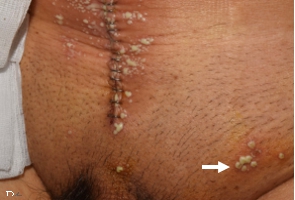膀胱摘除術後於傷口上形成之角質層下膿疱 - 一個罕見的病例報告
廖奕安、黃冠中、呂育全、張宏江
國立台灣大學附設醫院 泌尿部
Subcorneal pustule over surgical wound after radical cystectomy – a very rare case report
Yi-An Liao、Kuan Chong Ng、Yu-Chuan Lu、Hong-Chiang Chang
Department of Urology, National Taiwan University Hospital
Abstract
Introduction:
Acute localized exanthematous pustulosis is a very rare skin disease and has only been reported in a small number of patients. It is known as a rare form of drug reaction, especially from antibiotics containing amoxicillin, non-steroidal anti-inflammatory drugs, antifungal agents, calcium antagonists, antiulcer drugs and pembrolizumab. Here we present a case of bladder cancer with acute localized exanthematous pustulosis noticed after receiving laparoscopic radical cystectomy and ileal conduit reconstruction.
Case presentation:
A case of a 67-year-old man with history of bladder cancer(clinical staging T3aN0M0), presented with numerous skin pustules over surgical wound four days after laparoscopic radical cystectomy and ileal conduit reconstruction. The pustules were found over surgical wounds (Figure 1A), drainage wound, and inguinal area away from wounds (Figure 1B). The pustules confluent to pustular lakes, with white pus within. Neither fever nor itchy was reported. Culture from pus of the pustules was negative for infection. Skin biopsy revealed subcorneal pustules containing neutrophils, consistent with acute localized exanthematous pustulosis. Tracing back its medication history, post-operative medication include antibiotics(Flomoxef), Morphine, bronchodilators(Ipratropium,Salbutamol) and Esomeprazole. According to dermatologist’s suggestion, Esomeprazole was discontinued. Clobetasol propionate (Dermovate) was applied and showed much improvement. The patient was discharged afterwards with no skin pustules remained.


Figure 1: Pustules with white pus found over surgical wound after operation (A, arrow: confluent to pustular lakes), also at inguinal area (B, arrow: pustules at inguinal area)
Discussion:
Acute localized exanthematous pustulosis is a very rare skin disease usually related with drug reaction. In our case, the pustulosis appeared over surgical wound four days after laparoscopic radical cystectomy and ileal conduit reconstruction. Reviewing his medication history after operation, Esomeprazole was considered the most possible cause. Though the exanthematous pustulosis showed improvement after stopping Esomeprazole, implying the correlation between acute localized exanthematous pustulosis and Esomeprazole in this case, we still could not explain the distribution of the pustules over the surgical wound and not other skin area. Further research should be done to establish any correlation between acute localized exanthematous pustulosis and laparoscopic radical cystectomy.
Conclusion:
For patient with acute localized exanthematous pustulosis, drug reaction should be considered first, especially antibiotics and antiulcer drugs in patients receiving operation. We still could not establish the correlation between acute localized exanthematous pustulosis and laparoscopic radical cystectomy, and further research should be done in the future.
附件: